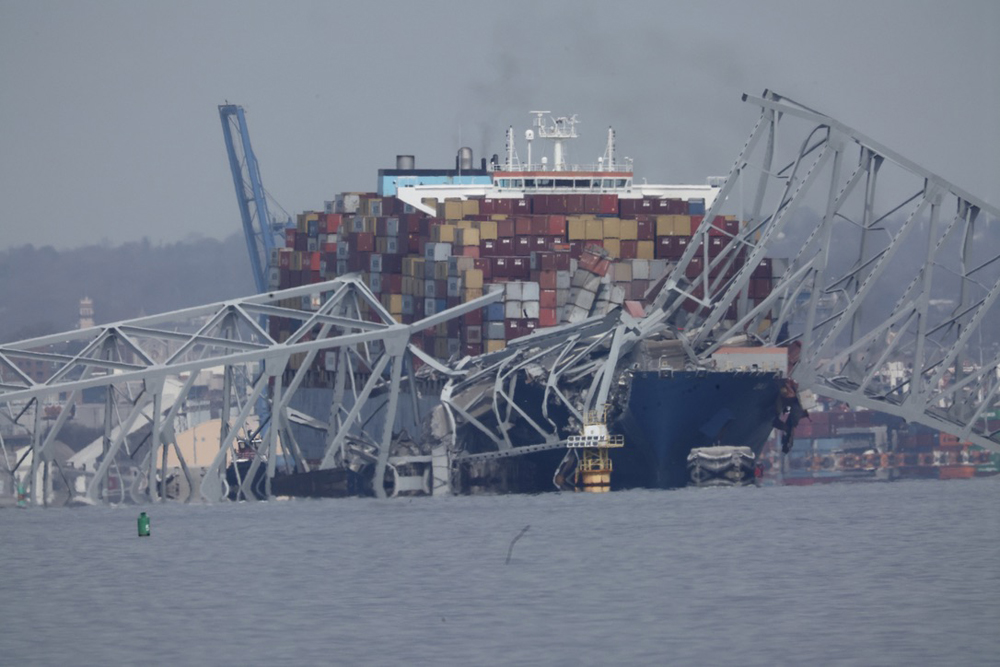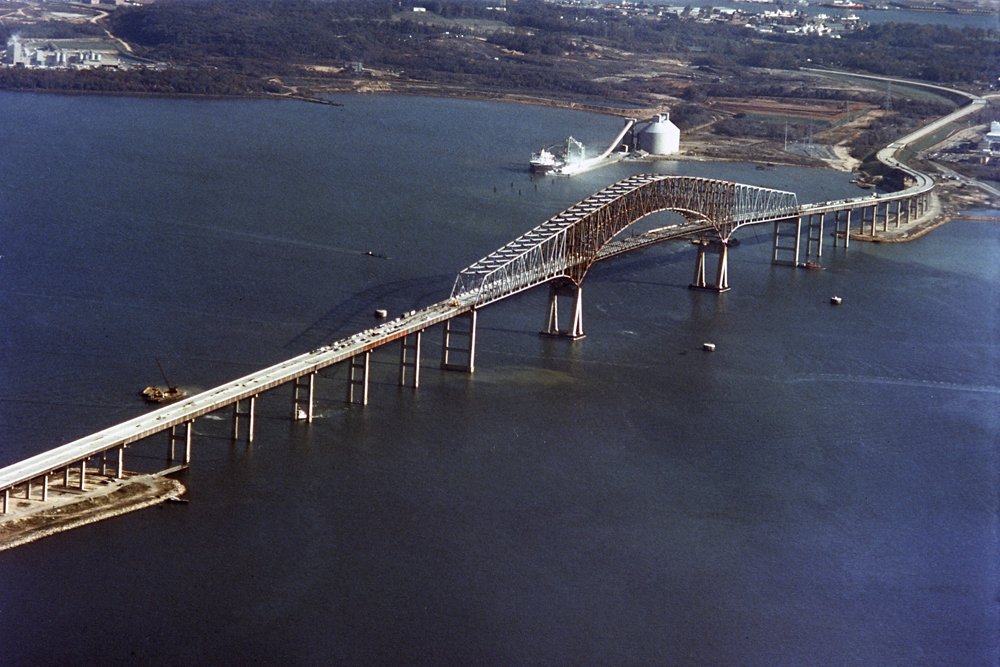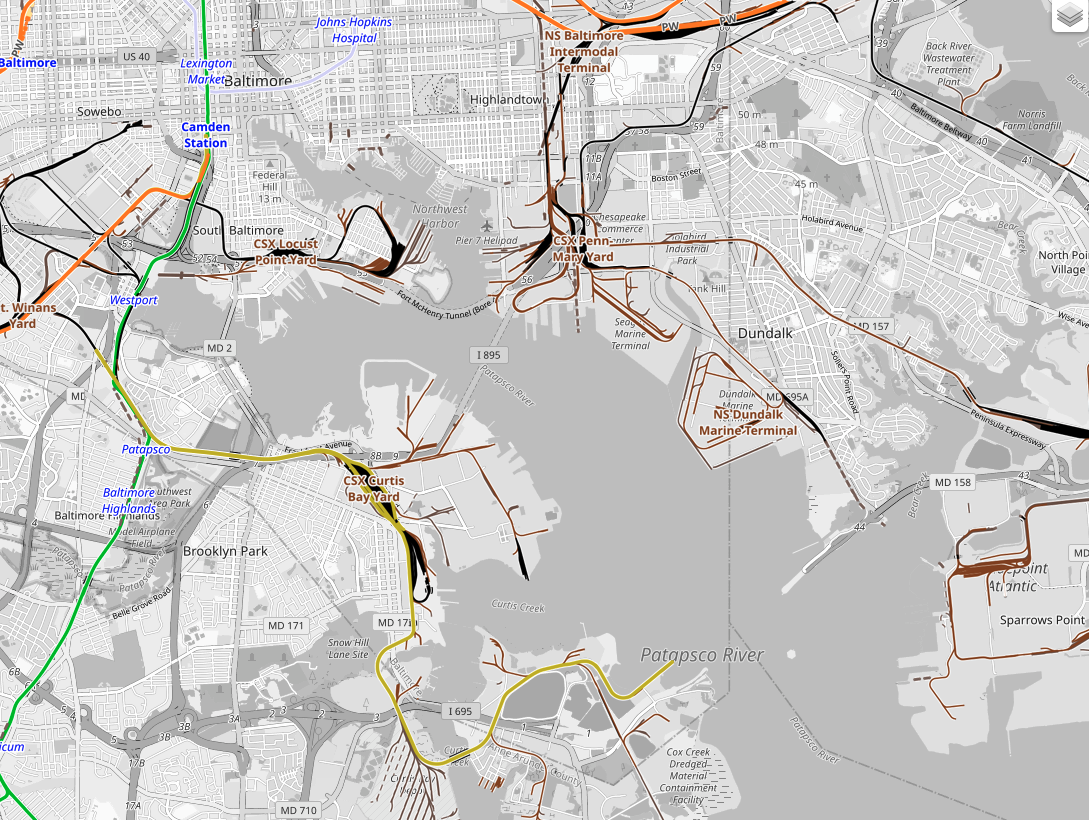
BALTIMORE — The tragic collapse of the Francis Scott Key Bridge today (March 26) after a ship strike has cut off the Port of Baltimore’s busiest terminals from Chesapeake Bay and the Atlantic Ocean beyond.
At least six people remain unaccounted for after the container ship Dali struck the bridge about 1:28 a.m. today, CNN reports. With rescue and recovery operations still under way, it’s unclear how long the debris from the bridge will block the Patapsco River. But for now ships can’t reach or leave the port’s container terminals, roll on-roll off auto and construction machinery terminals, and coal terminals.

CSX and Norfolk Southern serve the port, along with the short line Canton Railroad. The port had a record 2023 and is the largest automobile import facility on the East Coast. Last year it handled 750,000 vehicles, many of which moved inland by rail.
Port of Baltimore terminals that are blocked include:
- CSX’s Curtis Bay Coal Piers, which handles export coal produced at mines primarily in West Virginia and Pennsylvania.
- The Seagirt container terminal and adjacent Intermodal Container Transfer Facility
- The Dundalk Marine Terminal, the port’s largest general cargo facility, which handles containers, automobiles, farm and construction equipment, as well as wood pulp and steel.
- The Fairfield automobile terminal.
Port officials, in an update on X, formerly called Twitter, said vessel traffic in and out of the port is suspended until further notice. The port is still handling cargo that’s currently inside of its terminals.

“This is a major disaster and will create significant problems on the U.S. East Coast for U.S. importers and exporters,” says Lars Jensen, a maritime trade expert.
“The bridge collapse will mean that for the time being it will not be possible to get to the container terminals — or a range of the other port terminals — in Baltimore,” he says. “In 2023 the terminals handled 1.1 million TEU. This is some 21,000 TEU per week which now has to be routed through other ports in the region.”
TEU, or twenty-foot equivalent units, is the common measure of international containers. Baltimore’s container volume is dwarfed by the Ports of New York and New Jersey, as well as the Port of Virginia. In the fourth quarter, for example, Baltimore handled 265,000 TEU compared to 2 million at New York/New Jersey and 850,000 at Norfolk, Va.
“Should the Baltimore cargo be spread solely on the two nearest major container ports, NY/NJ and Norfolk, this would result in a throughput increase for those ports of just under 10%,” Jensen says. “The perhaps more critical question is to which degree truck and rail infrastructure can rapidly absorb such a 10% increase.”
CSX told customers to expect delays in the wake of the bridge collapse. “While freight traffic has not been entirely halted in the region, certain commodities have been affected by the incident. CSX is actively communicating with customers to provide updates on their shipment statuses as the situation evolves,” the railroad said in a statement.
CSX said it has the capacity to dispatch additional trains to CSX-served coal terminals in Baltimore. “Contingency plans are being implemented and CSX is in contact with existing coal customers through these terminals,” the railroad said. “The company currently intends to keep its Curtis Bay Coal Pier facility operational but will continue to assess the circumstances to determine appropriate actions moving forward.”
All international intermodal shipments destined for Baltimore have been suspended, CSX said: “The CSX team is working with International customers to identify alternative solutions to support cargo movement to and from Baltimore. It’s important to note that domestic intermodal traffic on CSX destined for local Baltimore remains unaffected.”
CSX CEO Joe Hinrichs expressed support for the community. “Our hearts go out to the individuals and families impacted by the tragic events surrounding the Francis Scott Key Bridge collapse,” he said in a statement. “The State of Maryland and the City of Baltimore have been central to our operations for nearly two centuries, and we remain deeply connected to this dynamic region. We stand in solidarity with the community during this difficult time.”
Paul Barnes, CEO of Canton Railroad parent Canton Development, says the closure of port facilities will have a major impact on rail traffic.
“First and foremost, my thoughts and prayers are with those lives lost in this tragic incident and with their families,” Barnes says. “The entire Port of Baltimore is closed for who knows how long. This will adversely impact the Canton Railroad specifically and Baltimore rail operations generally at least until the port re-opens.
“We will continue to interchange with CSXT and NS as we still have domestic rail customers, including through our beautiful Boston Street transload facility,” he adds. “This will greatly impact our traffic with international warehouse partners Rukert Terminals, Terminal Corp. and B&E Storage, all significant customers, just when opportunities were starting to grow.”
Norfolk Southern said it was working with customers affected by the port outage.
“We are working directly with affected international customers, port partners, and state officials to help maintain the integrity of the global supply chain. Ports on the East Coast are resilient and have the capacity to serve the flow of freight,” the railroad said in a statement. “Our network touches every major port on the eastern seaboard, and we have proactively reached out to help our customers and provide alternate routing solutions. Significant supply chain events demand a rapid response approach, frequent communication, and innovative solutions, and Norfolk Southern is doing all three of these things to help our customers and partners navigate through this challenge.”
Note: Updated at 2:27 Central with comment from CSX and at 8:25 p.m. Central with comment from NS; updated at 8:40 p.m. with photo of collapsed bridge.














One small correction to the otherwise very detailed and accurate map: Penn Mary Yard is jointly owned and served by CSX and Canton RR – CSX owns the northern half, Canton RR the southern half. CSXI and NS have trackage rights over the Canton portion to access Seagirt Marine Terminal for intermodal traffic.
This alleged container ship engine power failure reeks of sabotage.
Agreed. This was an act of economic terrorism.
I think it’s always best to wait for the incident report.
I agree with Mr. Landey. Railroad rule books have a lot of rules that testify to the things that can go wrong—not through malice, but by accident—when dealing with vehicles weighing thousands of tons. I’d be surprised if ships were much different in that regard.
I don’t know how quickly it can be done but It shouldn’t take too long to clear a channel through the wreckage.
Can’t be done until the NTSB gives the OK once its investigation is complete. That could take weeks. If not months/years.
60-70 years ago, shipping channel would have been opened in 10 days to 2 weeks. Now it takes a lot longer.
Firs it Will take a while to recover the victims and analyze what happened. Next they have to clear the debris, not just the remains of the bridge but from the containers and what was inside the containers (reports are more than 1,500 tons of chemicals, lithium batteries, and other hazardous materials) that fell into the river. If EPA has it’s way, before anything get’s done, an environmental impact statement must be conducted and a permit issued. Then the have to get a contractor to do the work (wonder if they have to bid out the contract).
Would be very surprised if it took less than 2 months. Probably somewhere in the neighborhood of 3 to 6 months before it gets cleared and open to ship traffic. At same time it wouldn’t surprise me if it took longer. Retired from Government and saw how long the process took to get accomplished.
Now, time line to replace the bridge?????
How will this affect the Delaware River ports? (I grew up near Philly)
Not good for CSX & NS. This is going to increase both RRs OR. False ammo to piranha investors truing to take over NS.